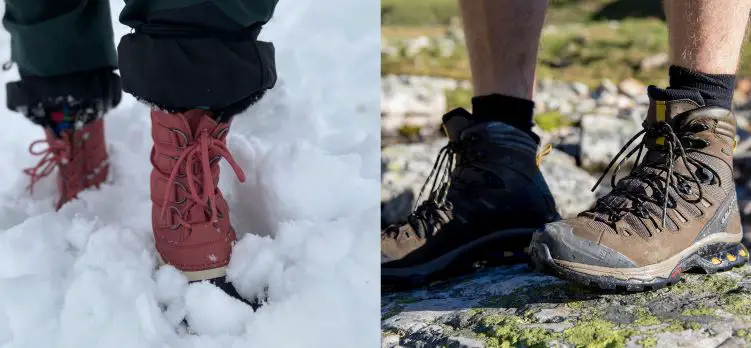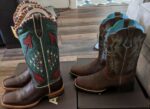There are days when you want to spend all the time outdoors. And when heading outside, you want to make sure you have the correct equipment, which requires some amount of research.
One thing to consider is the sort of boot you’ll be wearing.
Depending on your destination, you have to choose between hiking boots or snow boots.
Snow Boots are more appropriate if you intend to hike in snowy circumstances, since you’ll need solid traction to keep you on your feet while still remaining comfortable and dry. Hiking boots, on the other hand, are ideal for difficult routes that we may experience when walking those difficult trails.

What are Hiking Boots?
Hiking boots are used for both climbing and hiking. They’re intended to assist you in walking a wide range of terrain, including rocks, and even streams.
They’re ideal for cold weather since they offer plenty of insulation to keep you warm as well as providing waterproofing or water-repellent properties that will keep your feet dry and comfortable.
What are Snow Boots?
As the name suggests, snow boots are intended for use in the snow. They’re wonderful for a variety of situations, but they give you all the aid you need to be warm and dry when walking around throughout the winter and snowy days.
They are insulated and waterproof to keep everything out while keeping you comfortable on lengthy hikes in snow.
Differences between Hiking and Snow Boots
There are various parameters through which you can differentiate between snow boots and hiking boots and see which one suits you best.
1.) Traction- If you’re going to walk in the snow, the first thing you’ll want is boots with good grip to protect you from sliding and falling.
Snow boots are all meant to keep you upright in the snow, so you can count on them to have outstanding traction, but hiking boots vary in quality and are created for different sorts of trekking and terrain.
As long as you obtain a good pair of winter hiking boots, you should have plenty of traction, but snow boots win this round hands down.
2.) Water-resistance- Nothing is worse than getting wet feet, especially during winters.
Snow boots will surely be waterproof and will reach farther up your leg and have a snug cuff, so they’ll keep falling snow and rain out and protect you from having a wet foot even if you sink in heavy snow.
Hiking boots can be waterproofed if constructed of Gore-Tex, which should keep moisture out well.
However, they don’t rise up as high on your calf as snow boots, and they don’t have a tight cuff, so you may need to wear gaiters with them for further protection.
3.) Ankle support- The terrain becomes more difficult in the winter, and if you’re looking for adequate ankle support, a pair of snow boots will undoubtedly provide it because they come up high on the calf.
Hiking boots come in a variety of heights, so be sure you pick a higher-fitting pair.
4.) Insulation- Warm feet are naturally at the forefront of your attention when trekking in snowy circumstances.
Again, the amount of insulation of hiking boots depends on the type you choose, but plenty of hiking boots give all the warmth you need in a snowstorm, but all snow boots are well-insulated and provide lots of warmth, giving them a minor advantage here.
5.) Breathability- One disadvantage of snow boots’ reliability is that they are not extremely breathable, which means that if you go on a tough trek and develop sweaty feet, you’ll wind up with unwelcome moisture and smell within your boots.
A decent moisture-wicking hiking sock will obviously assist, but you could choose a more breathable hiking footwear instead.
6.) Comfort- Comfort is a major consideration when travelling long distances in winter conditions. Once broken in, lightweight, breathable hiking boots have gone a long way in terms of comfort, providing them a significant advantage over snow boots, which are heavy, thick, and not very breathable.
7.) Versatility- Good gear isn’t cheap, and a good pair of hiking boots can be worn on a variety of terrain all year round.
Snow boots are meant for one time use and will be stored for the rest of the year when it’s not snowing. Therefore, hiking boots are perhaps the most cost-effective option.
8.) Weight- While you shouldn’t anticipate the featherweight feel of trail running shoes, weight is still an important issue to consider when selecting any sort of hiking boots.
Hiking boots vary in weight, although they are typically lighter than snow boots, which are always made to be hefty.
Let us look at this comparison table below:
| Parameters | Hike boots | Snow boots |
| Traction | Traction totally depends on the model, however it is quite good. | Excellent snow traction. |
| Water-resistance | They use gore-Tex that are waterproof, although they aren’t as tall or have tight cuffs. | They are water-resistance and have tight cuffs to keep snow out. |
| Ankle-support | Not always, different heights. | Yes, these boots reach further up the calf. |
| Insulation | Comes in both insulated and non-insulated models. | Warm and well-insulated. |
| Breathability | Yes, they are breathable. | They’re not very breathable. |
| Comfort | Breathable, lightweight, and cosy. | Less comfortable since it is heavy, thick, and does not let your feet breathe. . |
| Versatility | Can be used all year round. | Can be used only in snow. |
| Weight | They are heavy, but still lighter than snow boots. | Extremely heavy. |
Things to take care of while wearing Hiking boots
1.) These boots often feature a high collar, however this is not always the case. This means they don’t always provide the ankle stability required for slippery surfaces such as ice.
2.) Despite the fact that they are intended to protect against the majority of rainy weather, they don’t have the same amount of waterproofing as proper snow boots.
3.) Not to add that the top of these boots isn’t near enough to the ankle to keep snow out.
4.) If you have a chance to walk through heavy snow, it will fall in around the top of your shoe. It completely destroys the purpose and leaves you chilly, wet, and quite unpleasant.
Things to take care of while wearing Snow boots
1.) Snow boots are made to be completely waterproof. They’re entirely sealed, which may cause your feet to sweat inside.
2.) If you wear them for an extended period of time, moisture will accumulate within the boot. You may avoid this problem by wearing the proper sort of socks that wick away perspiration.
3.) You’ll also notice that these boots are quite big and hefty. If you’re attempting to remain warm and dry, it’ll be well worth it. Otherwise, you can find it difficult to walk for long periods of time.
4.) You’ll have to get used to the extra weight, as they are heavy in nature.
FAQs
Do you require insulated hiking boots?
Yes, insulated footwear is required for hiking. Hiking may be done in any weather, and rapid changes in weather are typical. So having insulated boots to keep you warm is a fantastic idea.
Can snow boots be used as hiking boots?
Hiking may be done in your snow boots. However, wearing them for an extended period of time will not be pleasant. They are not suitable for long distance walks.
An excellent hiking boot provides adequate traction and ankle support.
Recommended Hiking boots for you
1.) THE NORTH FACE Men’s Boot
- WINTER READY.
- PREMIUM CONSTRUCTION.
- INSULATED WARMTH.
- CLIMB TO NEW HEIGHTS.
- GAITER COMPLIAN
Prices pulled from the Amazon Product Advertising API on:
Product prices and availability are accurate as of the date/time indicated and are subject to change. Any price and availability information displayed on [relevant Amazon Site(s), as applicable] at the time of purchase will apply to the purchase of this product.
This waterproof boot will keep your feet dry in the snow and rain.
2.) Salomon X Ultra Men’s Hiking Boots
These boots provide an incredible blend of comfort and lightweight, all while maintaining excellent toe protection, a sturdy frame, and an incredibly well-grip lug design.
Check it out here-
- Waterproof Hiking Boots
- A Better Way Down
- Adventure Awaits
- Time To Play ~
Prices pulled from the Amazon Product Advertising API on:
Product prices and availability are accurate as of the date/time indicated and are subject to change. Any price and availability information displayed on [relevant Amazon Site(s), as applicable] at the time of purchase will apply to the purchase of this product.
Recommended Snow boots
1.) The North Face Men’s Snow Boot
With a waterproof suede covering and a robust, gripping sole, these boots are ready for anything winter throws at you.
Check it out here-
- MOVE WITH EASE
- WATERPROOF DURABILITY
- RECYCLED INSULATION
- COMFORT & SUPPORT
- WINTER GRIP OUTSO
Prices pulled from the Amazon Product Advertising API on:
Product prices and availability are accurate as of the date/time indicated and are subject to change. Any price and availability information displayed on [relevant Amazon Site(s), as applicable] at the time of purchase will apply to the purchase of this product.
2.) Columbia Men’s Snow Boot
Another excellent high-ankle choice. Expect a combination of waterproof outer materials and thermal-reflective linings to keep your feet dry and warm during those snowy hikes.
Check it out here-
- Combination of waterproof leather, textile, webbing and metal hardware.
- Omni-HEAT Infinity reflective lining.
- OutDry waterproof breathable membrane
- ADAPT TRAX ~
Prices pulled from the Amazon Product Advertising API on:
Product prices and availability are accurate as of the date/time indicated and are subject to change. Any price and availability information displayed on [relevant Amazon Site(s), as applicable] at the time of purchase will apply to the purchase of this product.
What do we prefer?
We cannot really say that one boot is better than the other, as they both have their sets of advantages and disadvantages. And you’ll need both at the end of the day!
But hiking boots have a minor advantage over snow boots based on the parameters we considered most relevant, owing to their lighter weight, breathability, comfort, and adaptability.
And you can’t truly tackle winter terrain without snow boots.
It is therefore preferable to opt for hiking boots that are waterproof, rigid (allowing for more flexible trekking), have warm insulation, and a secure fit.











